1997 CHEVROLET MALIBU window
[x] Cancel search: windowPage 127 of 354
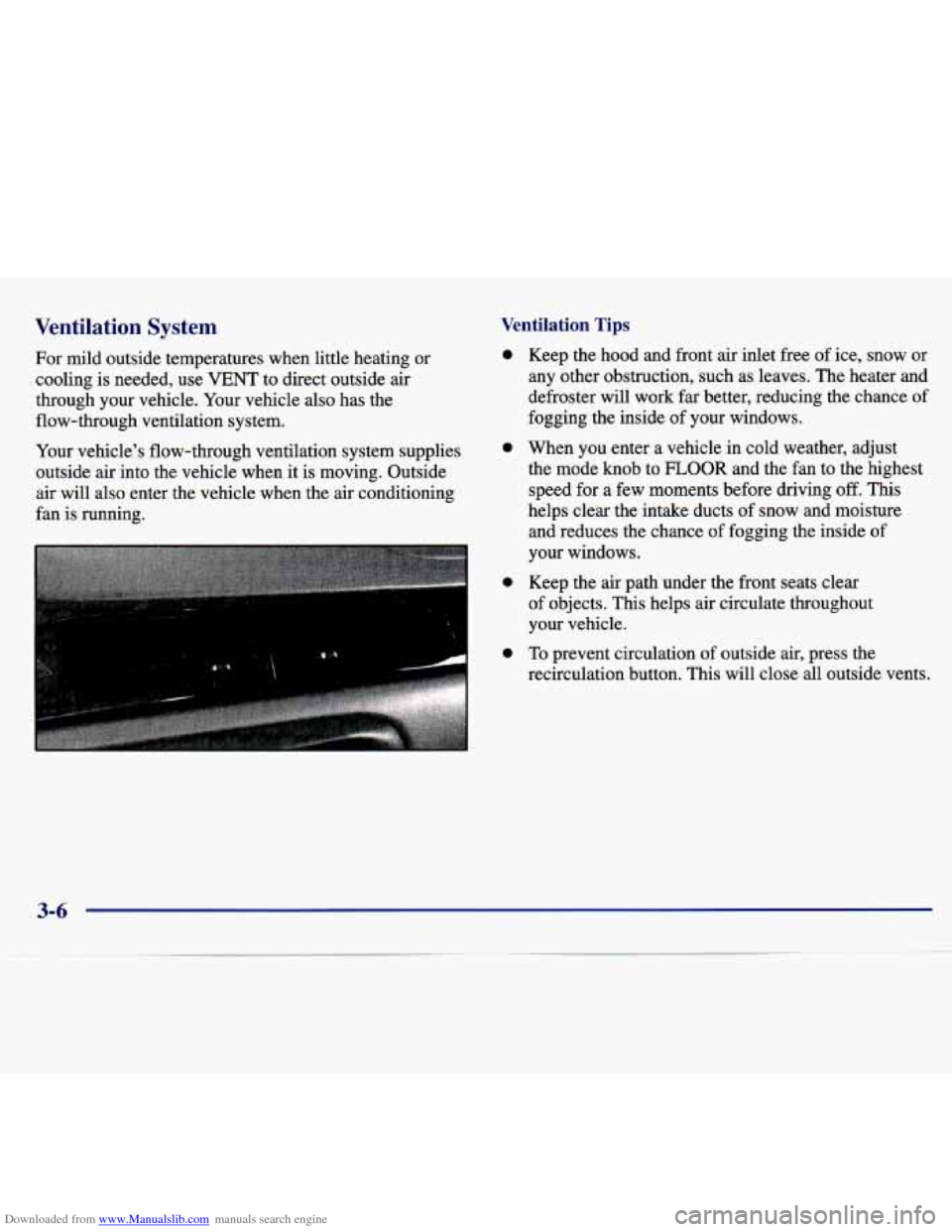
Downloaded from www.Manualslib.com manuals search engine Ventilation System Ventilation Tips
For mild outside temperatures when little heating or
cooling is needed, use VENT to direct outside
air
through your vehicle. Your vehicle also has the
flow-through ventilation system.
Your vehicle’s flow-through ventilation system supplies
outside air into the vehicle when
it is moving. Outside
air will also enter the vehicle when the air conditioning
fan
is running.
0
0
0
0
Keep the hood and front air inlet free of ice, snow or
any other obstruction, such as leaves. The heater and
defroster will work far better, reducing
. : chance of
fogging the inside of your windows.
When you enter a vehicle in cold weather, adjust the mode
knob to FLOOR and the fan to the highest
speed for a few moments before driving
off. This
helps clear the intake ducts of snow and moisture
and reduces the chance
of fogging the inside of
your windows.
Keep the air path under the front seats clear
of objects.
This helps air circulate throughout
your vehicle.
To prevent circulation of outside air, press the
recirculation button. This will close all outside vents.
3-6
Page 168 of 354
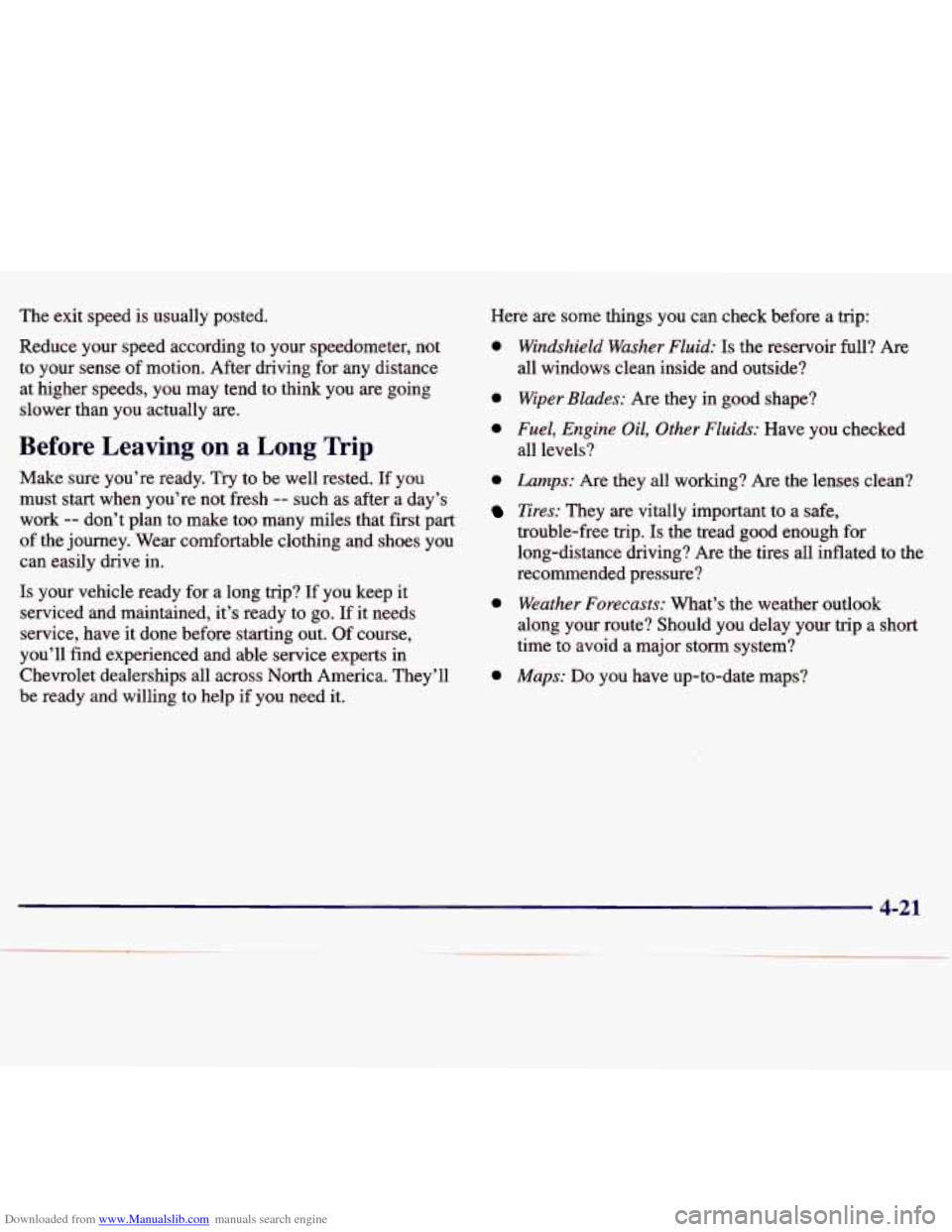
Downloaded from www.Manualslib.com manuals search engine The exit speed is usually posted.
Reduce your speed according to your speedometer, not to your sense
of motion. After driving for any distance
at higher speeds, you may tend to think you
are going
slower than you actually are.
Before Leaving on a Long Trip
Make sure you’re ready. Try to be well rested. If you
must start when you’re not fresh
-- such as after a day’s
work -- don’t plan to make too many miles that first part
of the journey. Wear comfortable clothing and shoes you
can easily drive in.
Is your vehicle ready for a long trip? If you keep
it
serviced and maintained, it’s ready to go. If it needs
service, have it done before starting out. Of course,
you’ll find experienced and able service experts
in
Chevrolet dealerships all across North America. They’ll
be ready and willing to help if you need it. Here
are some things you can check before a trip:
0
0
0
0
0
0
Windshield Washer Fluid: Is the reservoir full? Are
all windows clean inside and outside?
Wiper Blades: Are they in good shape?
Fuel, Engine Oil, Other Fluids: Have you checked
all levels?
Lamps: Are they all working? Are the lenses clean?
Tires: They are vitally important to a safe,
trouble-free trip. Is the tread good enough for
long-distance driving? Are the tires all inflated to the
recommended pressure?
Weather Forecasts: What’s the weather outlook
along your route? Should you delay your trip a
short
time to avoid a major storm system?
Maps: Do you have up-to-date maps?
4-21
Page 174 of 354
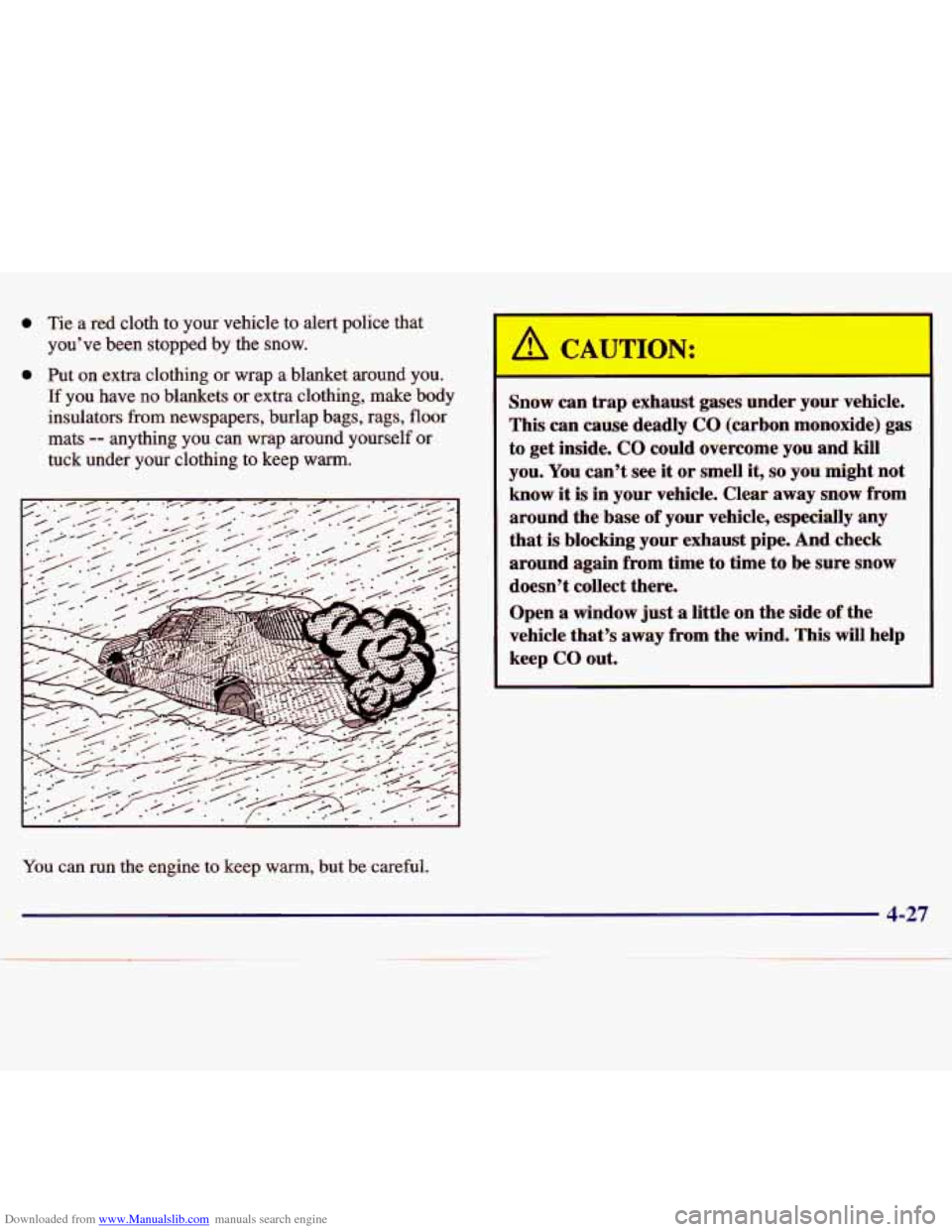
Downloaded from www.Manualslib.com manuals search engine 0 Tie a red cloth to your vehicle to alert police that
you’ve been stopped by the snow.
0 Put on extra clothing or wrap a blanket around you.
If you have no blankets or extra clothing,
make body
insulators from newspapers, burlap bags, rags, floor
mats
-- anything you can wrap around yourself or
tuck under your clothing to keep
warm.
You can run the engine to keep warm, but be careful.
A CAUTION:
Snow can trap exhaust gases under your vehicle.
This can cause deadly
CO (carbon monoxide) gas
to get inside.
CO could overcome you and kill
you. You can’t see it or smell it,
so you might not
know
it is in your vehicle. Clear away snow from
around the base of your vehicle, especially any
that is blocking your exhaust pipe. And check
around again from time to time to
be sure snow
doesn’t collect there.
Open a window just
a little on the side of the
vehicle that’s away from the wind. This
will help
keep
CO out.
4-27
Page 175 of 354
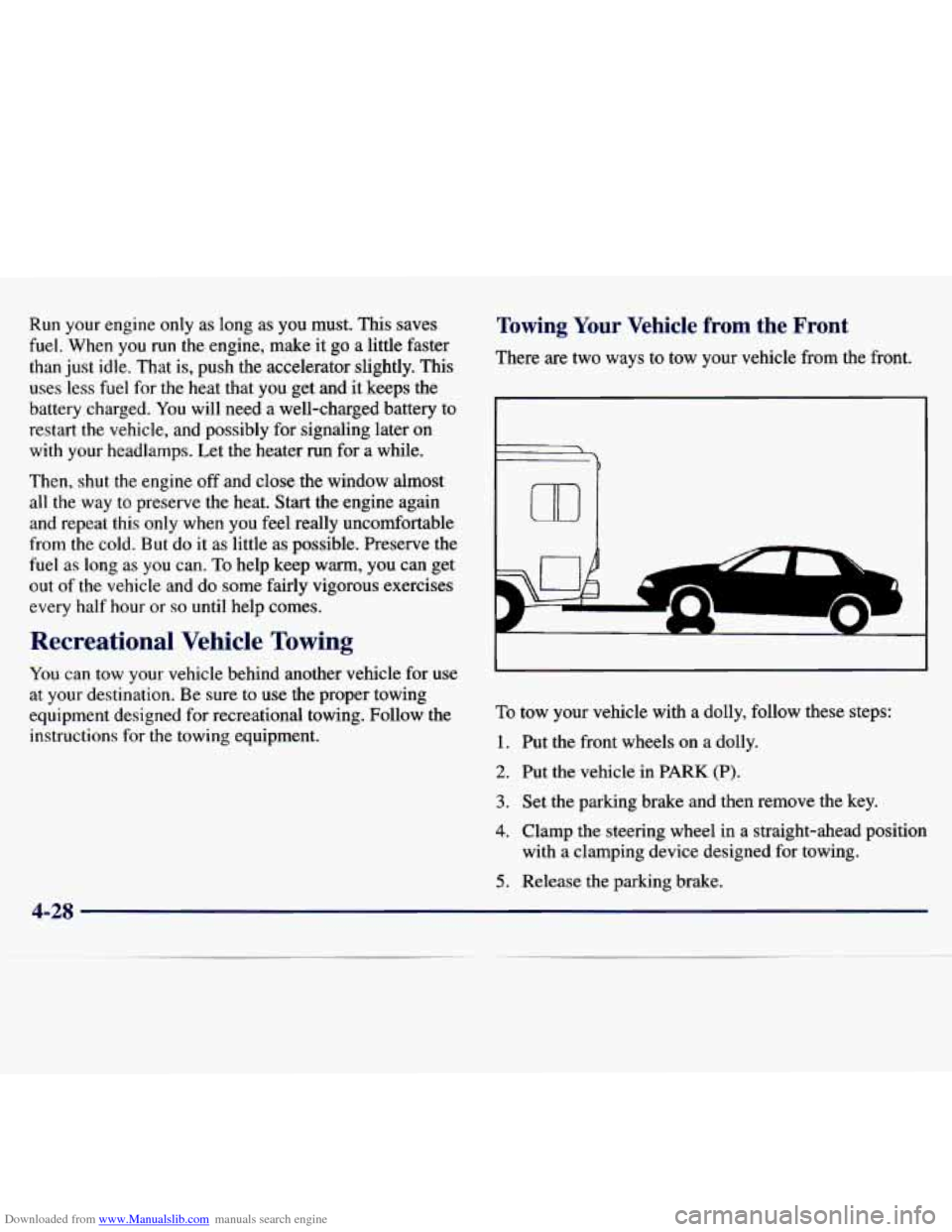
Downloaded from www.Manualslib.com manuals search engine Run your engine only as long as you must. This saves
fuel. When you run
the engine, make it go a little faster
than just idle. That is, push the accelerator slightly. This
uses less fuel
for the heat that you get and it keeps the
battery charged. You will need a well-charged battery to
restart the vehicle, and possibly for signaling later on
with your headlamps. Let the heater run for a while.
Then, shut the engine off and close the window almost
all the way to preserve the heat. Start the engine again
and repeat
this only when you feel really uncomfortable
from the cold.
But do it as little as possible. Preserve the
fuel as long as you can. To help keep warm, you can get
out
of the vehicle and do some fairly vigorous exercises
every half hour
or so until help comes.
Recreational Vehicle Towing
You can tow your vehicle behind another vehicle for use
at your destination. Be sure to use the proper towing
equipment designed for recreational towing. Follow the
instructions
for the towing equipment.
Towing Your Vehicle from the Front
There are two ways to tow your vehicle from the front.
To tow your vehicle with a dolly, follow these steps:
1. Put the front wheels on a dolly.
2. Put the vehicle in PARK (P).
3. Set the parking brake and then remove the key.
4. Clamp the steering wheel in a straight-ahead position
5. Release the parking brake. with a clamping device designed for towing.
4-28
Page 200 of 354
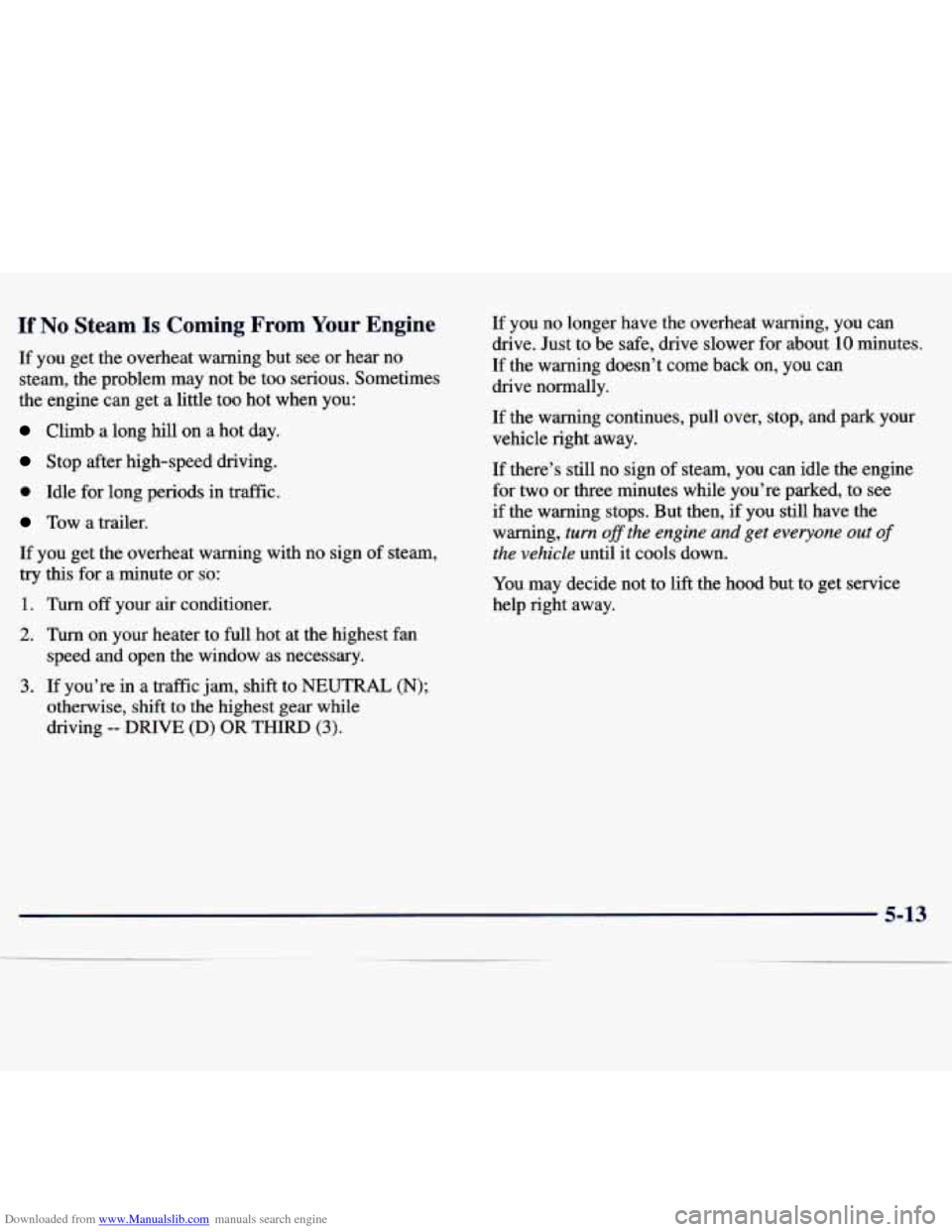
Downloaded from www.Manualslib.com manuals search engine If No Steam Is Coming From Your Engine
If you get the overheat warning but see or hear no
steam, the problem may not be too serious. Sometimes
the engine can get a little too hot when you:
Climb a long hill on a hot day.
Stop after high-speed driving.
0 Idle for long periods in traffic.
Tow a trailer.
If you get the overheat warning with no sign of steam,
try this for a minute or
so:
1. Turn off your air conditioner.
2. Turn on your heater to full hot at the highest fan
speed
and open the window as necessary.
3. If you’re in a traffic jam, shift to NEUTRAL (N);
otherwise, shift to the highest gear while
driving
-- DRIVE (D) OR THIRD (3).
If you no longer have the overheat warning, you can
drive. Just to be safe, drive slower for about
10 minutes.
If the warning doesn’t come back on, you can
drive normally.
If the warning continues, pull over, stop, and
park your
vehicle right away.
If there’s still no sign of steam, you can idle the engine
for
two or three minutes while you’re parked, to see
if the warning stops. But then,
if you still have the
warning,
turn off the engine and get everyone out of
the vehicle until it cools down.
You may decide not to lift the hood but to get service
help right away.
5-13
Page 265 of 354
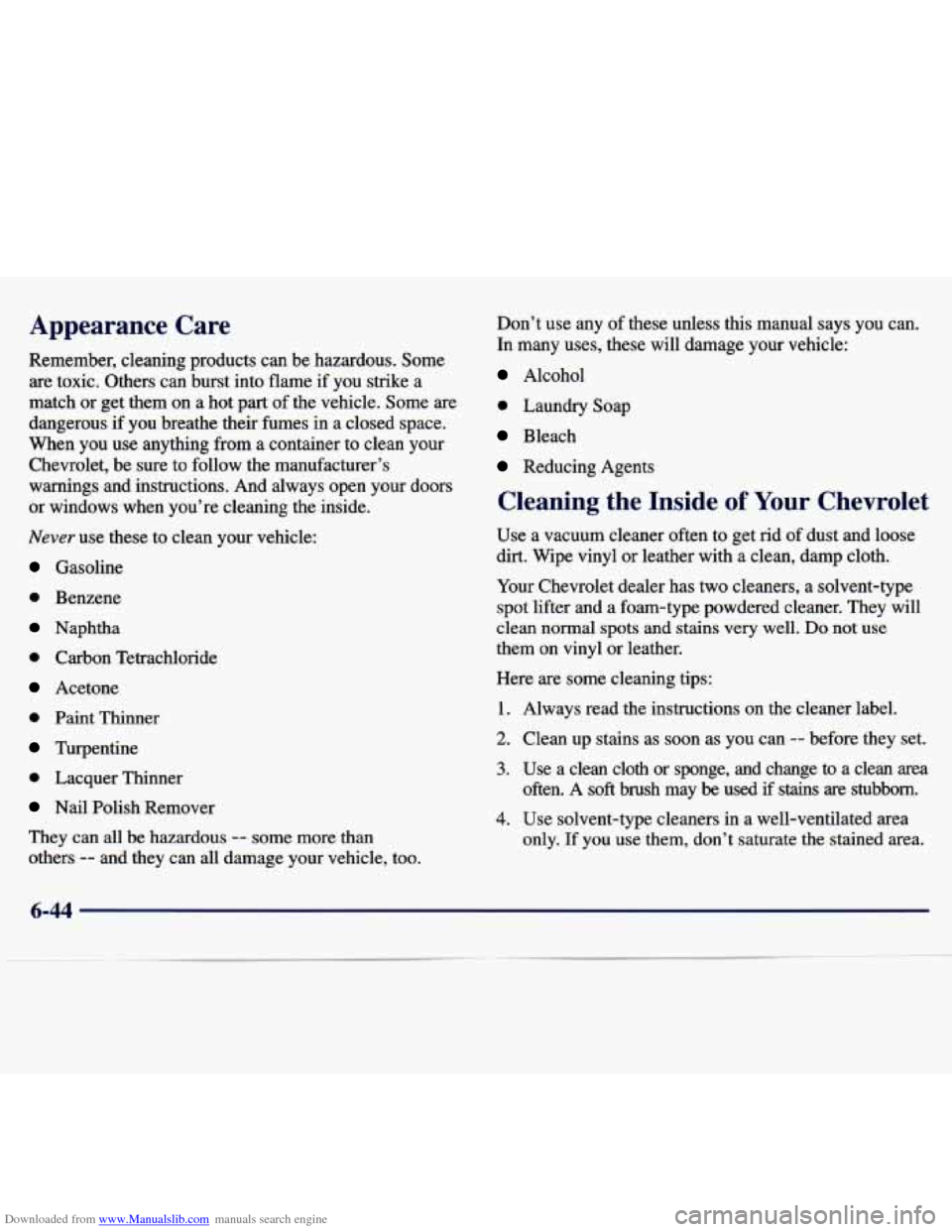
Downloaded from www.Manualslib.com manuals search engine Appearance Care
Remember, cleaning products can be hazardous. Some are toxic. Others can burst into flame
if you strike a
match or get them on a hot part of the vehicle. Some are
dangerous
if you breathe their fumes in a closed space.
When you use anything from a container to clean your
Chevrolet, be sure to follow the manufacturer’s
warnings and instructions. And always open your doors
or windows when you’re cleaning the inside.
Never use these to clean your vehicle:
Gasoline
0 Benzene
Naphtha
0 Carbon Tetrachloride
Acetone
0 Paint Thinner
Turpentine
0 Lacquer Thinner
Nail Polish Remover
They can all
be hazardous -- some more than
others -- and they can all damage your vehicle, too. Don’t use any
of these unless this manual says you can.
In many uses, these will damage your vehicle:
Alcohol
0 Laundry Soap
Bleach
Reducing Agents
Cleaning the Inside of Your Chevrolet
Use a vacuum cleaner often to get rid of dust and loose
dirt. Wipe vinyl or leather with a clean, damp cloth.
Your Chevrolet dealer has two cleaners, a solvent-type
spot lifter and a foam-type powdered cleaner. They will
clean normal spots
and stains very well. Do not use
them on vinyl or leather.
Here are some cleaning tips:
1. Always read the instructions on the cleaner label.
2. Clean up stains as soon as you can -- before they set.
3. Use a clean cloth or sponge, and change to a clean area
often. A
soft brush may be used if stains are stubborn.
4. Use solvent-type cleaners in a well-ventilated area
only.
If you use them, don’t saturate the stained area.
Page 268 of 354
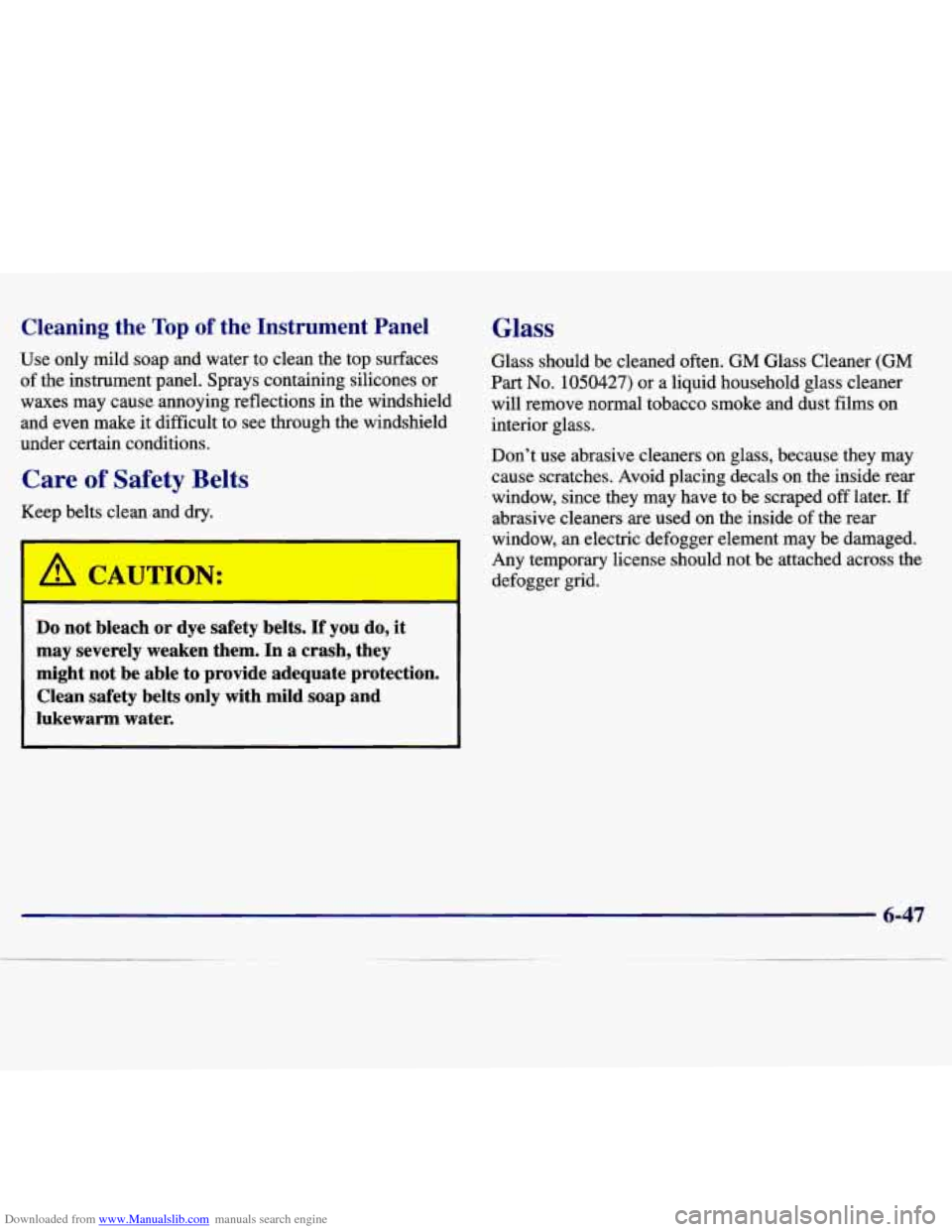
Downloaded from www.Manualslib.com manuals search engine -leaning the Top of the Instrument Panel
use only mild soap and water to clean the top surfaces
of the instrument panel. Sprays containing silicones or
waxes may cause annoying reflections in the windshield
and even make it difficult to see through the windshield
under certain conditions.
Care of Safety Belts
Keep belts clean and dry.
I
CAUTION:
-
Do not bleach or dye safety belts. If you do, it
may severely weaken them.
In a crash, they
might not be able to provide adequate protection. Clean safety belts only with mild soap and
lukewarm water.
Glass
Glass should be cleaned often. GM Glass Cleaner (GM
Part No. 1050427) or a liquid household glass cleaner
will remove normal tobacco smoke and dust films on
interior glass.
Don't use abrasive cleaners on glass, because they may
cause scratches. Avoid placing decals on the inside rear
window, since they may have to be scraped off later.
If
abrasive cleaners are used on the inside of the rear
window, an electric defogger element may be damaged.
Any temporary license should not be attached across the
defogger grid.
6-47
Page 275 of 354
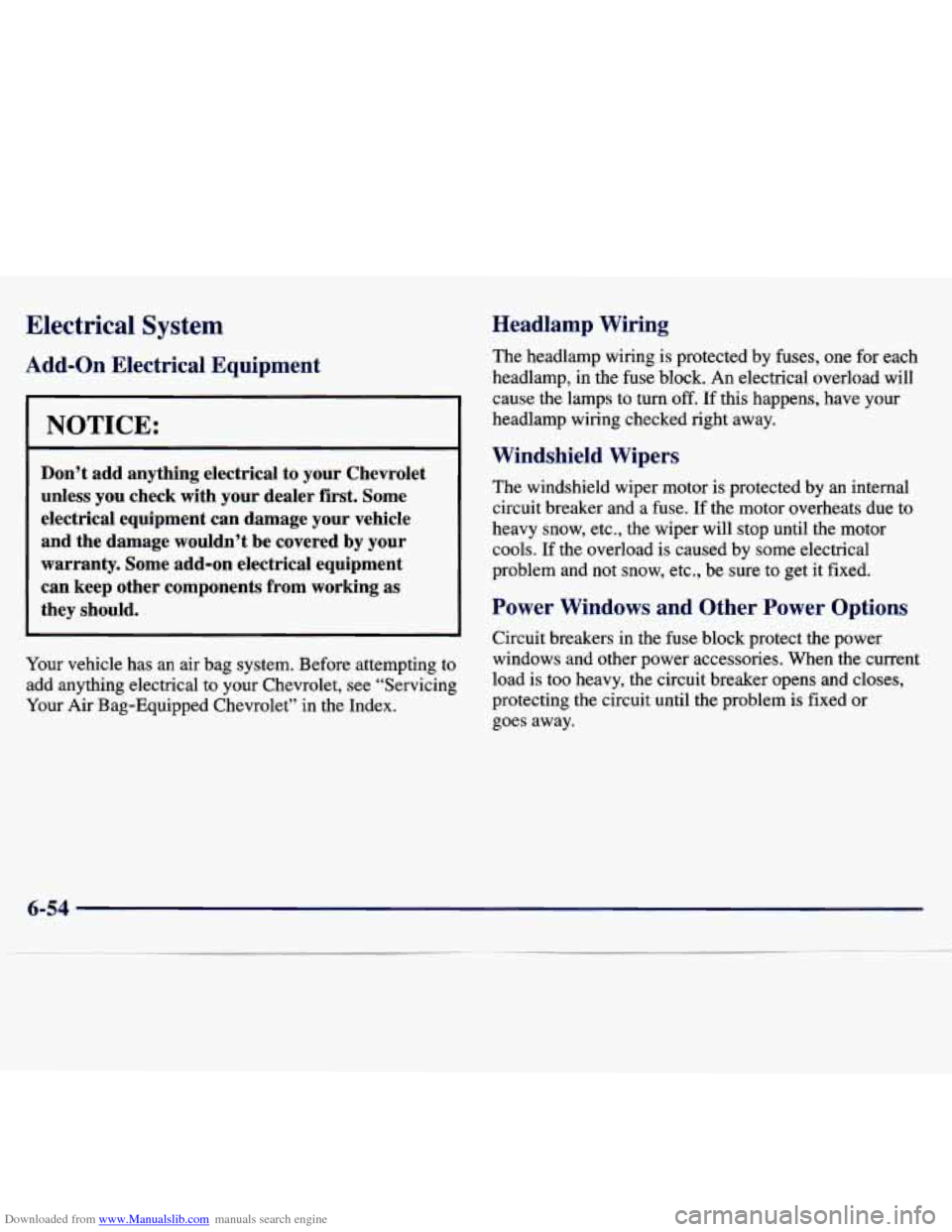
Downloaded from www.Manualslib.com manuals search engine Electrical System Headlamp Wiring
Add-on Electrical Equipment
NOTICE:
Don’t add anything electrical to your Chevrolet
unless you check with your dealer first.
Some
electrical equipment can damage your vehicle
and the damage wouldn’t be covered by your
warranty. Some add-on electrical equipment
can keep other components from working as
they should.
Your vehicle has an air bag system. Before attempting to add anything electrical to your Chevrolet, see “Servicing
Your Air Bag-Equipped Chevrolet” in the Index. The
headlamp wiring is protected by fuses, one for each
headlamp, in the fuse block.
An electrical overload will
cause the lamps to turn
off. If this happens, have your
headlamp wiring checked right away.
dshield Wipers
lne windshield wiper motor is protected by an internal
circuit breaker and a fuse.
If the motor overheats due to
heavy snow, etc., the wiper will stop until the motor
cools. If
the overload is caused by some electrical
problem and not snow, etc., be sure to get it fixed.
Power Windows and Other Power Options
Circuit breakers in the fuse block protect the power
windows and other power accessories. When
the current
load is too heavy, the circuit breaker opens and closes,
protecting the circuit until the problem
is fixed or
goes away.
6-54